|
Very few writers in contemporary India have written as successfully on such a wide range of important subjects as Pavan K. Varma. His writings have made landmark contributions in the areas of biography, social sciences, civic affairs, history, translations and journalism.
|
BIOGRAPHY
Ghalib: The Man, the Times (Viking/Penguin 1988) |
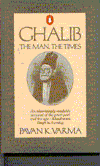 |
An absorbingly readable account of the great poet and his age – Khushwant Singh in Sunday
This path-breaking biography of nineteenth century India’s greatest poets captures evocatively the spirit of the man and the essence of the times he lived in. Hailed as a major contribution to the life and times of Ghalib, this book has been praised by Critics for the range of its research and the depth of its insight. Professor Gopi Chand Narang, President Sahitya Akademi, has publicly stated that as a result of the research which has gone into the book, Pavan K. Varma is one of three people in the twentieth century, along with British author Ralph Russel and Russian writer Natalia Pregerina, who have contributed most to popularizing and extending the reach of Ghalib’s legacy. The book has been translated into Urdu, its translator having won the Sahitya Akademi Award for it. In fact, the Sahitya Akademi is in the process of getting the book translated into all the major Indian languages.
|
|
| Krishna : The Playful Divine (Viking/Penguin 1993) |
| This seminal book on one of the most popular divinities of the Hindu pantheon has become a standard reference book in the study of Hindu religion and culture. Among the numerous raving reviews received, The Times of India called the book a “celebration” and recommended it as “an immensely good read.” The Frontline called it “an extraordinary book … The quality of the prose, the literary verve … could hardly be improved….” Krishna has also been published in an abbreviated form (The Book of Krishna) as part of the Penguin series on the Divinities of India and been released as an Audio Book. |
 |
|
| The Great Indian Middle Class (Viking/Penguin 1998) |
 |
This book, described by The Hindu as “The first popular social history of the class that has shaped India’s recent past and still controls the key to its future,” was published to coincide with the fiftieth anniversary year of India’s Independence. The powerful and insightful analysis made it a great success, keeping it at the top of the Bestseller List for many months. The book argues that the project for the “secession of the successful” is as dangerous as it is unrealistic in a country like India. It emphasizes that the middle class needs to remain sensitive to the needs of the vast number of Indians in its own interests and for the very prosperity it desires. The Great Indian Middle Class has already been translated into Hindi, Malyalam and Marathi. K. Natwar Singh in The Hindustan Times rated it “Not only the most outstanding non-fiction book of 1998, it is among the best that have come out of India in the past two decades.” The book was also rated as the Book of the Year by Khushwant Singh.
|
|
Maximise Your Life: An Action Plan for the Indian Middle Class (Viking/Penguin 2000) |
As a follow-up to The Great Indian Middle Class, Pavan K. Varma, in association with journalist Renuka Khandekar, wrote this manual to help middle class Indians with the rationale and the tools to help them evolve from being mere residents to responsible citizens. This book urges educated Indians to engage in the process of national development. Among the problems and possible solutions that it deals with are Inefficiency and callousness in public institutions and what we must do to make them more accountable; How to fight corruption and injustice through the judicial system and the press; How small acts of “involvement” – like making one person functionally literate – can make a difference; and How to support or link up with existing non-government organization or set up one ourselves.
The book also gives practical advice to ensure a more civil, humane and caring society with inspiring profiles of ordinary people who have made a difference. Its Hindi translation, Adarsh Nagrik Jeevan, has also been published and was launched by Deputy Prime Minister Shri L. K. Advani in 2000. |
 |
|
People Like Us (Har-Anand 2001) |
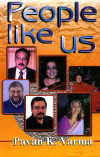 |
In 1998, after the success of The Great Indian Middle Class, Pavan K. Varma began to write a fortnightly column in The Hindustan Times called “People Like Us.” “People Like Us” sought to profile people and organisations who had somehow broken through the barriers of apathy, cynicism and alienation and found ways to contribute in personally satisfying ways to society over and above their normal preoccupations. Such people could prove to be role models for those who want to do a little extra in their lives to create a better nation and a better society. The widely read column served to inspire its readers and help the individuals and organisations it covered. The book, of the same name, put together all the columns and has become a reference book for information on NGOs, and for those working to contribute constructively to society.
|
|
Havelis of Old Delhi (Span Tech, London, 1992 & Bookwise, India, 1999) |
| A deep concern about the need to remember and preserve the old city of Delhi, the repository of so much culture and history, which now lies in the shadow of a new metropolis, prompted Pavan K. Varma to undertake this intense and time-consuming task of documenting its story, both textually and visually. For eighteen months, Varma and photographer Sondeep Shankar walked through the streets of Old Delhi – past alleys through doorways, up the narrow staircases and down mildewed basements – to produce this invaluable and enduring document of a lost era. Through this book, an entire period of Indian history comes alive. The book has also contributed to the attempts to try and preserve the fast eroding architectural ethos of the old city. First published in 1992, the book was re-launched by the Chief Minister of Delhi in 1999. |
 |
|
Delhi (Harper-Collins 1993) |
This book, a collaboration between Pavan K. Varma and internationally renowned photographer Raghu Rai, captures the multiplicity of this city of paradoxes – the seat of power for centuries, for Hindu kings and Mughal emperors, the British empire and modern India today. The text, written by Pavan K. Varma, provides a lucid account of Delhi’s history from the days of Indraprastha to modern times. Written lyrically in the first person by a narrator who has been a prisoner of the past for too long, the flowing and sensitive text sums up the historical perspective with remarkable ease. India Today labelled the text exquisite, and many others spoke of the poetic insight it provided to the soul of a great city.
|
| The Millennium Book on New Delhi (Oxford University Press, 2001) |
 |
This book was inspired by a proposal by the Deputy Prime Minister, Shri L. K. Advani, to portray New Delhi through words and pictures as the capital of the world’s largest democracy and a symbol of the hopes and aspirations of the Indian people. Pavan K. Varma co-edited this ambitious project focussing exclusively for the first time on the character and personality of New Delhi, its history, its republican character, its planning, its flora and fauna, its cultural heritage, its social life, its problems and its economic activities. The book was launched by the then President of India, Shri K.R. Narayanan, at Rashtrapati Bhawan, in the presence of the Vice President, the Prime Minister and the Deputy Prime Minister. |
|
TRANSLATIONS
Twenty-one Poems by Atal Bihari Vajpayee (Viking/Penguin 2001) |
| This English translation of a selection of the poems of Shri Atal Bihari Vajpayee provides a rare and rewarding glimpse into the mind of the leader of over a billion people. Pavan K. Varma’s translations have been widely praised and have formed the basis for translations into foreign languages as well. Shri Vajpayee, in a very gracious gesture, himself wrote to Shri Varma to say that the translations had made his poems even “more meaningful.” |
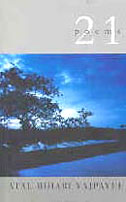 |
|
Selected Poems: Kaifi Azmi (Penguin 2001) |
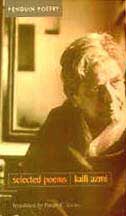 |
This brilliant translation by Pavan K. Varma of the ghazals and poems of the late Kaifi Azmi, the most honoured Urdu poet in the country, has been widely hailed not only for its literary qualities but also for bringing to a wider audience the wisdom and lyricism of Azmi’s poetry. In the Author’s Note to the book Kaifi Azmi himself writes that in Pavan K. Varma he had “found a Translator with a fine ear and a finer pen.” The poet acknowledged that he was well acquainted with Pavan K. Varma’s work on Ghalib and wrote further: “When Shabana first gave me the news that Pavan Varma would be translating my Poems and would have them published, I thought Shabana was saying this only to please me but, today, this Book symbolises the fulfilment of my dreams …” |
|
POETRY
Yudhishtir & Draupadi (Viking 1999) |
This book, made up entirely of sonnets, explores the fascinating relationship between two of the leading characters of the Mahabharata, Yudhishtir and Draupadi. It also dwells on one of the most revealing segments of the epic, the Yaksha Prashna. The book has been enacted as dance-theatre by Kathak exponent Shovana Narayan, in association with Sunit Tandon, to a very enthusiastic response in New Delhi (on several occasions), Trivandrum , Ludhiana , Bangalore , Kathmandu , and other places.
|
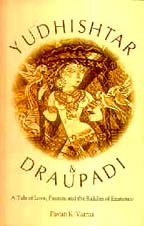 |
|
Widows of Vrindavan (2002) |
| This short poem, which movingly describes the unfortunate plight of the widows of Vrindavan, was the basis for a dance theatre performance by Bharatnatyam danseuse Prathibha Prahlad in 2002. The poetic monograph was launched by Shri Murli Manohar Joshi, the then Minister of Human Resource Development and has been widely used to sensitise public opinion by NGOs working for the welfare of the widows in Vrindavan.
|
Love and Lust: An Anthology of Erotic Literature from Ancient and Medieval India (HarperCollins 2004) |
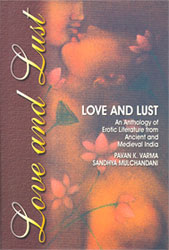 |
A compendium of evocative and sensual writings spanning 5000 years of Indian literature, this volume could well be called the most comprehensive anthology of erotic literature produced in India till date. Pavan K. Varma, who co-edited the book along with Sandhya Mulchandani, forcefully drives home the point that the fascination with eroticism is age-old. The well-represented and balanced selections, which form the volume, express with amazing clarity the absence of inhibition and guilt and bring to fore the candour and boldness with which Indian society of yore set about seeking its pleasures. The book forces our attention back to issues which we are now prone to dismiss more easily under the garb of “immorality” and compels us to rethink our own tradition through its evident writings and re-decide as to who we are and where we are headed. On the literary side, the book’s range of contents is simply astounding – from ancient texts like the Vedas, the Upanishads, the epics such as the Mahabharata and the Ramayana, the Brahmanas, the Puranas, devotional hymns such as Adi Shankara’s Saundarya Lahiri to the writings of Jayadeva, Kalidasa and many others – each piece a treat to read and mull over. |
|
Being Indian (Penguin/Viking 2004)
|
|
Misconceptions about India and Indians abound, fed by the stereotypes created by foreigners, and the myths about themselves projected by Indians. In this book, Pavan K. Varma demolishes these myths and generalizations as he turns his sharply observant gaze on his fellow countrymen to examine what really makes Indians tick and what they have to offer the world in the twenty-first century.
The author’s insightful analysis of the Indian personality and the culture that has created it reaches startling new conclusions on the paradoxes and contradictions that characterize Indian attitudes towards issues such as power, wealth and spirituality. Drawing on sources as diverse as ancient Sanskrit treatises and Bollywood lyrics, and illuminating his examples with a wealth of telling anecdotes, Pavan K. Varma creates a vivid and compelling portrait of Indians as he argues that they will survive and flourish in the new millennium precisely because of what they are, warts and all, and not because of what they think they are or would like to be. Being Indian stimulates refection, discussion and controversy, and is a must read for anyone who wishes to understand Indians and for Indians who wish to understand themselves.
|
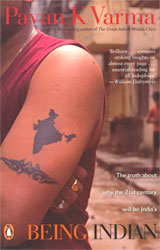 |
|
| |
| Copyright © 2006. All rights reserved |